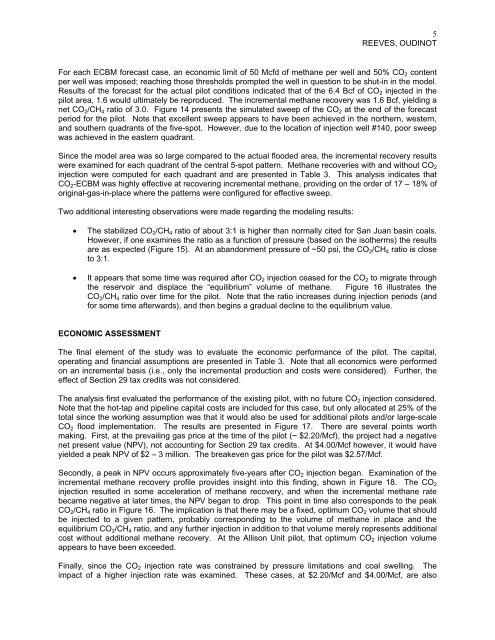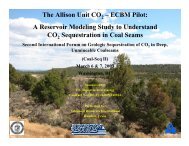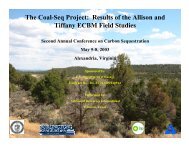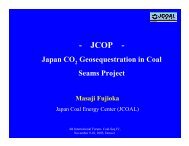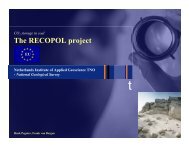The Allison Unit CO2-ECBM Pilot - A Reservoir and ... - Coal-Seq
The Allison Unit CO2-ECBM Pilot - A Reservoir and ... - Coal-Seq
The Allison Unit CO2-ECBM Pilot - A Reservoir and ... - Coal-Seq
You also want an ePaper? Increase the reach of your titles
YUMPU automatically turns print PDFs into web optimized ePapers that Google loves.
5<br />
REEVES, OUDINOT<br />
For each <strong>ECBM</strong> forecast case, an economic limit of 50 Mcfd of methane per well <strong>and</strong> 50% CO 2 content<br />
per well was imposed; reaching those thresholds prompted the well in question to be shut-in in the model.<br />
Results of the forecast for the actual pilot conditions indicated that of the 6.4 Bcf of CO 2 injected in the<br />
pilot area, 1.6 would ultimately be reproduced. <strong>The</strong> incremental methane recovery was 1.6 Bcf, yielding a<br />
net CO 2 /CH 4 ratio of 3.0. Figure 14 presents the simulated sweep of the CO 2 at the end of the forecast<br />
period for the pilot. Note that excellent sweep appears to have been achieved in the northern, western,<br />
<strong>and</strong> southern quadrants of the five-spot. However, due to the location of injection well #140, poor sweep<br />
was achieved in the eastern quadrant.<br />
Since the model area was so large compared to the actual flooded area, the incremental recovery results<br />
were examined for each quadrant of the central 5-spot pattern. Methane recoveries with <strong>and</strong> without CO 2<br />
injection were computed for each quadrant <strong>and</strong> are presented in Table 3. This analysis indicates that<br />
CO 2 -<strong>ECBM</strong> was highly effective at recovering incremental methane, providing on the order of 17 – 18% of<br />
original-gas-in-place where the patterns were configured for effective sweep.<br />
Two additional interesting observations were made regarding the modeling results:<br />
• <strong>The</strong> stabilized CO 2 /CH 4 ratio of about 3:1 is higher than normally cited for San Juan basin coals.<br />
However, if one examines the ratio as a function of pressure (based on the isotherms) the results<br />
are as expected (Figure 15). At an ab<strong>and</strong>onment pressure of ~50 psi, the CO 2 /CH 4 ratio is close<br />
to 3:1.<br />
• It appears that some time was required after CO 2 injection ceased for the CO 2 to migrate through<br />
the reservoir <strong>and</strong> displace the “equilibrium” volume of methane. Figure 16 illustrates the<br />
CO 2 /CH 4 ratio over time for the pilot. Note that the ratio increases during injection periods (<strong>and</strong><br />
for some time afterwards), <strong>and</strong> then begins a gradual decline to the equilibrium value.<br />
ECONOMIC ASSESSMENT<br />
<strong>The</strong> final element of the study was to evaluate the economic performance of the pilot. <strong>The</strong> capital,<br />
operating <strong>and</strong> financial assumptions are presented in Table 3. Note that all economics were performed<br />
on an incremental basis (i.e., only the incremental production <strong>and</strong> costs were considered). Further, the<br />
effect of Section 29 tax credits was not considered.<br />
<strong>The</strong> analysis first evaluated the performance of the existing pilot, with no future CO 2 injection considered.<br />
Note that the hot-tap <strong>and</strong> pipeline capital costs are included for this case, but only allocated at 25% of the<br />
total since the working assumption was that it would also be used for additional pilots <strong>and</strong>/or large-scale<br />
CO 2 flood implementation. <strong>The</strong> results are presented in Figure 17. <strong>The</strong>re are several points worth<br />
making. First, at the prevailing gas price at the time of the pilot (~ $2.20/Mcf), the project had a negative<br />
net present value (NPV), not accounting for Section 29 tax credits. At $4.00/Mcf however, it would have<br />
yielded a peak NPV of $2 – 3 million. <strong>The</strong> breakeven gas price for the pilot was $2.57/Mcf.<br />
Secondly, a peak in NPV occurs approximately five-years after CO 2 injection began. Examination of the<br />
incremental methane recovery profile provides insight into this finding, shown in Figure 18. <strong>The</strong> CO 2<br />
injection resulted in some acceleration of methane recovery, <strong>and</strong> when the incremental methane rate<br />
became negative at later times, the NPV began to drop. This point in time also corresponds to the peak<br />
CO 2 /CH 4 ratio in Figure 16. <strong>The</strong> implication is that there may be a fixed, optimum CO 2 volume that should<br />
be injected to a given pattern, probably corresponding to the volume of methane in place <strong>and</strong> the<br />
equilibrium CO 2 /CH 4 ratio, <strong>and</strong> any further injection in addition to that volume merely represents additional<br />
cost without additional methane recovery. At the <strong>Allison</strong> <strong>Unit</strong> pilot, that optimum CO 2 injection volume<br />
appears to have been exceeded.<br />
Finally, since the CO 2 injection rate was constrained by pressure limitations <strong>and</strong> coal swelling. <strong>The</strong><br />
impact of a higher injection rate was examined. <strong>The</strong>se cases, at $2.20/Mcf <strong>and</strong> $4.00/Mcf, are also


